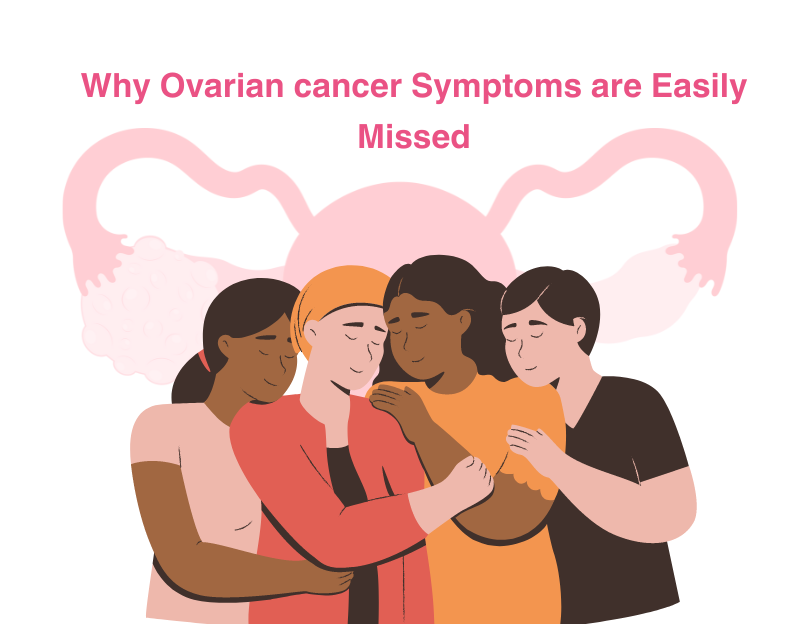
23 Dec, 2025
Feel free to reach out to us.

23 Dec, 2025

This article is medically reviewed by Dr. Abhilasha Narayan, Consultant – Gynec Oncology & Robotic & Laparoscopic Surgeon, HCG Cancer Centre, Bangalore.
Women have two ovaries, located on either side of the uterus. The ovaries produce eggs and release progesterone and estrogen.
When the cells of the ovaries multiply abnormally with the potential to invade other organs and tissues, the disease is known as ovarian cancer. The two most common treatments for ovarian cancer are chemotherapy and surgery.
Studies have reported that ovarian cancer ranks eighth on the list of the most common cancers in women. Globally, ovarian cancer accounted for approximately 3.7% of cases, and there were 4.7% of cancer deaths in the year 2020.
In the early 2000s, the highest incidences of ovarian cancer were reported in North America and Europe. However, this trend has shifted, and there has been a higher incidence in Asia and Eastern Europe in recent years.
Any woman may develop ovarian cancer. However, women with certain risk factors are at greater risk of developing ovarian cancer than those without those factors.
Women over the age of 40 have a higher chance of developing this cancer. Almost 50% of ovarian cancer cases are diagnosed in women 63 years of age and older.
Obesity may also increase the risk of ovarian cancer. Obese women with ovarian cancer also have poorer outcomes than women with a normal weight.
Women who have never achieved pregnancy or became pregnant after 35 years of age are at increased risk for ovarian cancer.
Women on hormone replacement therapy after menopause and having a family history of breast cancer, ovarian cancer, and colorectal cancer are at increased risk for developing ovarian cancer.
Women with a history of breast cancer are also at elevated risk of having ovarian cancer.
Most women do not experience symptoms in the early stages of ovarian cancer. Although early-stage ovarian cancer may present with certain symptoms, the diagnosis is delayed due to ignoring these symptoms.
A study reported that women with high-risk early-stage ovarian cancer experience symptoms such as pelvic or abdominal pain.
"Ovarian cancer symptoms are often subtle and can include bloating, pelvic or abdominal pain, difficulty
eating or feeling full quickly, and urinary urgency or frequency. If these symptoms persist for more
than a few weeks, it is important to seek medical advice for early detection and better outcomes."
Dr. Abhilasha Narayan
Another study reported that the symptoms may occur for several months before the diagnosis.
The symptoms experienced by patients with cancer are more frequent, severe, and persistent than the symptoms experienced in women without ovarian cancer. It has been reported that the symptoms of ovarian cancer go unrecognized for several months until they are diagnosed.
Awareness about the symptoms of ovarian cancer and the associated risk is low among women. Almost 50% of women with ovarian cancer are not directly referred to gynecologists (from primary care physicians), resulting in a delayed diagnosis.
The following are the ovarian cancer symptoms:
Commonly observed ovarian cancer symptoms include:
Apart from common symptoms, certain ovarian cancer symptoms are less common or are often seen in the advanced stages. The following are the less common signs of ovarian cancer:
There are several reasons why ovarian cancer goes unnoticed. The most common is the presence of non-specific symptoms.
Patients have signs of ovarian cancer, such as stomach pain, pelvic pain, menstrual changes, changes in bowel habits, and fatigue.
However, none of these symptoms are specific to ovarian cancer. These symptoms may also be caused by less severe conditions, such as hormonal and gastrointestinal problems.
The other reason for ovarian cancer to go unnoticed is negligence associated with symptoms. People ignore their symptoms and wait for them to subside on their own. This results in a delayed diagnosis.
Another reason is the lack of awareness about ovarian cancer. People are unaware of the risk factors and symptoms of ovarian cancer.
Following are some of the techniques for ovarian cancer diagnosis:
"Diagnosing ovarian cancer typically involves a combination of pelvic examinations, imaging tests like ultrasounds or CT scans, and blood tests, including CA-125. If these indicate a potential issue, a biopsy or surgery may be needed to confirm the diagnosis and determine the cancer stage and treatment plan."
Dr. Abhilasha Narayan
ultrasound is usually used as an initial imaging test to determine the presence of ovarian masses. However, due to advancements in imaging techniques and the availability of much more sophisticated techniques that deliver relatively clearer images, its use as a preferred imaging technique for ovarian cancer has been reduced.
There are several reasons why ultrasound may not always diagnose ovarian cancer. These include limitations in visualizing small lesions, no differentiation between benign and malignant lesions, and an inability to evaluate the deep pelvic structures.
Initial ovarian cancer symptoms are similar to those of various less serious conditions. It is important to consult the doctor if the patient experiences symptoms of concern, especially if they are at higher risk of developing ovarian cancer.
Patients should book an appointment with the doctor if they experience stomach ache, persistent abdominal bloating, pelvic or belly pain, cramping, urinary issues, menstrual changes, changes in bowel habits, back pain, fatigue, weight loss or gain, and painful sex.
Ovarian cancer, arising from abnormal cell growth in the ovaries, poses significant health risks, especially to women over 40. Ovarian cancer symptoms, often non-specific, include stomach and pelvic pain, urinary and menstrual irregularities, and fatigue.
Awareness and timely medical consultation are crucial for diagnosis and treatment. Diagnostic methods include blood tests, imaging, colonoscopy, laparoscopy, and biopsy, aiding in accurate diagnosis and tailored treatment plans. Early detection improves outcomes.

Dr. Abhilasha Narayan
MBBS, MS (OBG), DNB (OBG)
Consultant – Gynec Oncology & Robotic & Laparoscopic Surgeon
Dr. Abhilasha Narayan is an experienced consultant - gynecological oncology and robotic and laparoscopic surgeon at the HCG Cancer Centre, a leading cancer hospital in Bangalore. She has received specialized training in gynecological oncology and has vast experience treating cervical and ovarian cancer. Dr. Abhilasha also has extensive experience in colposcopy, administering chemotherapy, and palliative care management of cancer patients. She takes a collaborative approach to care, providing guidance and support to her patients throughout their treatment.
If you are looking for a surgical oncologist in Bangalore for gynecological cancer, you have reached the right place. To book an appointment with Dr. Abhilasha Narayan, please click here.